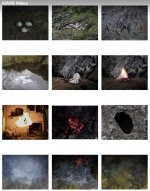raydm6
Yay! Cameras! 🙈🙉🙊┌( ಠ_ಠ)┘ [◉"]
I am curious if you consider color temperature while shooting and do you do color temperature adjustments in post? I am aware this is so for studio and other critical shooting situations, but I am thinking more for casual shooters. There are so many variables: type/quality of light, film chosen (especially color), WB camera setting (digital), filtration etc.
I see some really wonderful photographs here shot in various lighting situations. When outdoors, I tend to like sunny but diffused light. I sort of unscientifically and intuitively feel the quality of the light that I'm shooting in and sometimes - if it's really harsh - don't shoot at all unless it is totally necessary.
My light-meter app shows a white-balance/color-temp scale but my software doesn't allow post temperature adjustments other than white-balance from what I can see.
Just curious your thoughts...
I see some really wonderful photographs here shot in various lighting situations. When outdoors, I tend to like sunny but diffused light. I sort of unscientifically and intuitively feel the quality of the light that I'm shooting in and sometimes - if it's really harsh - don't shoot at all unless it is totally necessary.
My light-meter app shows a white-balance/color-temp scale but my software doesn't allow post temperature adjustments other than white-balance from what I can see.
Just curious your thoughts...
farlymac
PF McFarland
I definitely take advantage of the CT settings in camera so I don't have to mess with them in post, mainly because sometimes the software I use doesn't have the flexibility to make proper corrections sometimes.
PF
PF
RichC
Well-known
rumbliegeos
Well-known
I have had difficulties with WB for some time. The settings in my Nikon D7000 never look good to my eyes, except in sunny conditions. Because of where I often shoot lots of documentary images (Scotland), overcast conditions are common. Under those conditions I have found auto WB yields too cool images, the overcast setting is too warm, and even manually setting the WB requires further tweaking. Is this normal? I'd rather not do lots of post-processing corrections.
Chriscrawfordphoto
Real Men Shoot Film.
I shoot everything in RAW and set white balance when I process the images. In-camera white balance is never perfect and is often incredibly bad.
Here's a White Balance Tutorial that I wrote a few years ago.
Here's a White Balance Tutorial that I wrote a few years ago.
raydm6
Yay! Cameras! 🙈🙉🙊┌( ಠ_ಠ)┘ [◉"]
Thank you everyone and thank you Chris for your informative tutorial!
Chriscrawfordphoto
Real Men Shoot Film.
Thank you everyone and thank you Chris for your informative tutorial!
You're welcome. Hope you had a merry Christmas.
willie_901
Mentor
When I did commercial interiors photography I though a great deal about color temperature during pre-production. This involved using gels for off-camera lighting. There are many inconvenient techniques for dealing with color temperature differences for outdoor photography used by high-end commercial photographers. One of the least expensive (and least flexible) solutions are gradient, color, lens filters (link). Otherwise, when clients are concerned with skin and, or product color perception more tedious (expensive ) methods are useful. For example, motion picture crews shooting interior scenes will apply temporary film gels to all exterior windows to match color temperature and light levels. Resort and fashion photographers will supplement exterior sunlight with gelled, high-power strobes.
Except in very low light conditions the raw file information content of newer digital cameras means post-production techniques are just as good as many pre-production solutions. With some practice, selective, region-by-region color temperature rendering parameters eliminate the need for pre-production solutions.
So, you can spend either time and effort before or after the shutter closes. For me, the greater the difference in color temperature, the more I relied on pre-production solutions.
Except in very low light conditions the raw file information content of newer digital cameras means post-production techniques are just as good as many pre-production solutions. With some practice, selective, region-by-region color temperature rendering parameters eliminate the need for pre-production solutions.
So, you can spend either time and effort before or after the shutter closes. For me, the greater the difference in color temperature, the more I relied on pre-production solutions.
Share:


